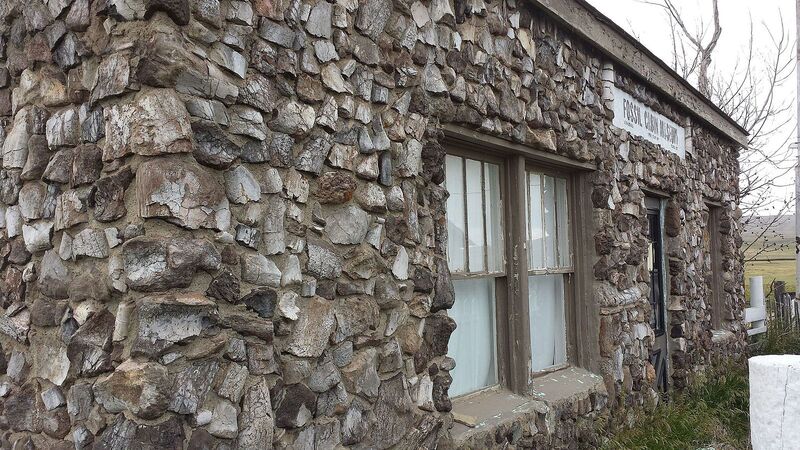Fossil Cabin

In 1915, Thomas Boylan began collecting dinosaur bones from Como Bluff, Wyoming. He wanted to complete a dinosaur skeleton to attract motorists to his gas station along the Lincoln Highway, but when he couldn’t find enough bones he gave up and used them to build the Fossil Cabin instead.
Thomas Boylan settled in Medicine Bow, Wyoming, sometime in the early 1900s. In 1915, he began searching for dinosaur bones at Como Bluff, a rocky ridge between the towns of Medicine Bow and Rock River known for being abundant with fossils. As early as 1877, professor of paleontology Othniel Charles Marsh employed men to excavate at the ridge. In 1897, The American Museum of Natural History found numerous fossils of sauropods. Dinosaur species that used to inhabit the area included massive herbivores like Brontosaurus, Diplodocus, Camarasaurus, Barosaurus, and Stegosaurus. The climate and diversity of plants in the region provided plenty of sustenance for them. The presence of so many herbivores attracted predators like Ceratosaurus, Ornitholestes, and Allosaurus. Boylan searched for dinosaur bones because he hoped to put together a complete skeleton as a roadside attraction for drawing motorists to his gas station on the Lincoln Highway to get more business. Boylan’s method was unorthodox, but he shared the impulse for roadside attractions with other early-twentieth-century American gas station owners.
Despite so much “dino-diversity,” spending nearly sixteen years excavating dinosaur fossils, and finding 5,796 dinosaur bones, Boylan did not get even close to completing an entire dinosaur skeleton. Like other early twentieth-century American gas station owners, he wanted to build something uniquely eccentric to attract motorists and bring in more business. Like the famous Route 66, Lincoln Highway is known for its many strange roadside attractions, like the Koontz Coffee Pot and the World’s Largest Teapot.
Lacking a complete skeleton, Boylan decided to put the dinosaur fossils he found to a different use: building a small museum out of dinosaur bones. He completed the Fossil Cabin Museum in 1932. Boylan built the cabin like any other tradition brick structure at the time, except he included fossil chunks and fragments among the bricks, sealing them in place with mortar. During the Fossil Cabin’s construction, part of Boylan’s house served as a museum.
The Fossil Cabin was initially very successful as a museum and roadside attraction. The Lincoln Highway was a popular road at the time, and Boylan had no lack of business. Newspapers called it the “world’s oldest” building because of its fossil building material, and the Fossil Cabin even featured in Robert Ripley’s Believe It or Not newspaper.
Boylan operated the Fossil Cabin museum until his death in 1947. His wife, Grace Boylan, continued its operation until 1970. That year, workers completed construction of the US Interstate 80 nearby. Traffic decreased, the gas station went out of business, and the museum lost attention. Grace finally sold the museum in 1974.
The Boylans’ gas station is gone, and except for the Fossil Cabin, the property looks abandoned today. Though the National Park Service added it to the National Register of Historic Places in 2008, Fossil Cabin has been closed to the public since 2011. The property is currently for sale, and its future is uncertain. It remains a very unique roadside attraction along the Lincoln Highway, and there’s still a paved area for motorists to park, take pictures, and marvel at the “World’s oldest” building.
Images


